Car racing in the physics classroom Teach article
Physical science teacher Nicolas Poynter wanted his students not only to learn but also to think for themselves. His solution: a competition to build the fastest car!
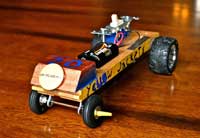
Image courtesy of Nicolas
Poynter
To motivate my students and teach them about simple machines, electricity, experimental variables, the laws of motion and the scientific method, I developed a car-racing project, spanning the topics of the entire first block of a standard textbook for ninth-grade (aged 15) physical science in the USA (Hsu, 2005). Teams should compete to construct the fastest car, using the knowledge gained in lessons.
I felt that the usual textbook activities were too constrained: the students followed instructions as if baking a cake. I wanted to make them reason and think. The project was a complete success: not only did the students gain a deep understanding of the subjects, but their enthusiasm was strong and infectious.
The activity
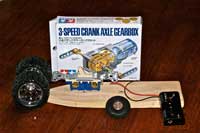
the activity
Image courtesy of Nicolas
Poynter
Timing: Each section described below takes approximately 80 minutes: 20 minutes for the introduction, and an hour for practical work. Before starting, students should know about measurements, unit conversions and the scientific method.
I taught the class every day of the week, alternating between introductory laboratory activities and the car project: e.g. after two days of simple circuit construction, we would advance to building a circuit from scratch for the project.
Rules: In addition to a gearbox, each car should have a wooden chassis, be powered by two 1.5 volt batteries, and have a switch included in the design of the circuit.
Car components
Each group of students needs:
- A gearbox and motor (identical for each team). I used a three-speed gearbox with a 3 V motor from Tamiyaw1 (item #70093), but any will do
- A battery holder
- A standard switch
- A pine, bamboo or oak board (7.5 cm x 25 cm x 2 cm) for the chassis
- A set of three or four tyres (a selection for the students to choose from).
I bought old remote-controlled cars cheaply and then pulled wheels, axles and motors off for parts. However, anything that rolls, such as screen-door castors, can be used as wheels; many cheap, acceptable items can be found in any hardware store or on the Internet.
Hardware and supplies
- 1.2 cm screws (suitable for wood)

Image courtesy of Nicolas
Poynter - 5 cm bolts with washers and nuts
- 0.8 mm thick wire
- Eye hooks and J hooks
- Solder
- Electrical tape
- Glue suitable for metal, wood and plastic – the stronger the better
- Paint and brushes
- 3 mm diameter aluminium rod (for the front axles), approximately 3 cm per car. The Tamiya gearbox kit comes with a spare axle that can also be used for the front.
- Coarse sandpaper
- Pencils
- Grease (from the gearbox kit)
Tools
- A soldering iron
- A box saw
- Wire cutters
- Small screw drivers
- A small carpenter’s square
- A drill and small drill bit
- Weighing scales
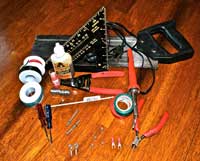
required for the activity
Image courtesy of Nicolas
Poynter
Additional materials
- Two prototype cars, one set on high speed (low torque), the other set on low speed (high torque). These will take about one afternoon to build. It is vital for the students to be able to continually refer to a working model, even though they may greatly deviate from it in their own design.
- Optional: a bicycle with gears
- Optional: a NERF™ toy gun (a type of childproof plastic gun) with styrofoam bullets, sticky tape
- Two photogates and a 10 m phone cord (to time the car race)
Assembling the gearboxes: gears and sliding friction
Students should learn the function of gearing as they construct the gearbox for their car, and understand the parallels with the gears in a real car and bicycle. Newton’s laws and gears should be covered before you start.
- Introduce the two prototype cars. Demonstrate that one is faster on an even surface, but unable to climb steep gradients (>45 degrees) while the other, low-speed, high-torque car can handle these easily (see image below, on the left).
- Optionally, you may mount a bicycle on the desk to show the students that at the lowest gear ratio, the tyre spins most per turn of the pedals. At the highest gear ratio, the tyre does the fewest revolutions per turn of the pedals, reducing the force necessary to pedal (as when climbing a hill). Thus, when it is easiest to pedal, the speed is smallest. This really helped my students understand the purpose of gearing.
- Give each team of two to four students one of the identical gearboxes.
- Tell the students that their cars will race on level ground.

Image courtesy of Nicolas
Poynter
From the very beginning of the project, I told them the precise length of the race and the track: 10 m on a waxed floor. It is important that they know the distance they are aiming for: some cars run straight for 5 m and then fly off course.
- Ask the students to select a gear ratio (16.6:1, 58.2:1 or 203.7:1) and assemble the gearbox, following the supplier’s directions. They should choose the high-speed setting (16.6:1). If they choose incorrectly, they won’t realise this until they test the cars and will then have to reassemble their gearbox – quite a lot of work. The two prototypes help them decide correctly and minimise this extra work.
- Place the leads across a battery to check that the motor is operating properly and that the axle is spinning.
- Apply grease to the gears to reduce friction, increasing speed. The results are minor, so many teams forget to grease their gears later on. The important thing is for them to understand that sliding friction means lower efficiency. This is an opportunity to explain that the standard automobile (internal combustion engine) is less than 25% efficient because of all the moving parts – all the sliding friction.
Designing the chassis: Newton’s second law of motion and air resistance
The students should understand Newton’s second law of motion, and air resistance (drag), and translate what they have learned to the design of their car chassis.
-
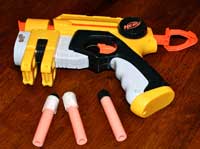
Demonstrating Newton’s
second law of motion with a
NERFTM gun, styrofoam
bullets and tape
Image courtesy of Nicolas
PoynterIntroduce Newton’s second law of motion, and the concept of air resistance.
I used a simple NERF gun which fires toy foam bullets with the same force every time. I wrapped sticky tape around some bullets to increase their mass, and had students weigh them (for some reason, it makes all the difference whether they weigh them or the teacher does). Then I asked my students how far the bullets would fly: if a bullet had twice the mass of another, it would go half as far. The law is fundamentally simple, but it is also vital to winning this car race.
- Show the students the prototype cars. Mine had a 7.5 cm x 25 cm x 2 cm wooden chassis made from bamboo.
- Ask each team to choose the material (a board cut to similar proportions) for their chassis.
I gave students the choice of oak, pine or bamboo, with pine being the lightest. Balsa would also be possible, and is even lighter. I chose bamboo, the densest and least efficient, for the prototype, in order to reward teams that selected the lightest wood, rather than those that simply copied the prototype. Weighing scales were available in the classroom. I guided the students as little as possible, but answered all their questions and ensured that they all had a choice between heavy and light wood.
When the finished cars were weighed several lessons later, I explained why pine was the best choice.
- Ask the students to draw their design on the wood for further cutting. The teacher should do the cutting with a box saw.
- Let the students sand the chassis.
- Paint and number the cars.
Students should attempt to make their cars lighter by choosing the right wood, cutting pieces away, and sanding their cars into more aerodynamic shapes.
Wiring the chassis: simple electric circuits and motors
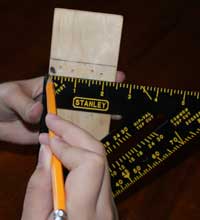
perpendicular line to mount
the gearbox on the chassis
Image courtesy of Nicolas
Poynter
Students should learn about simple electric circuits and electric motors. They should have been instructed on voltage, current and resistance, as well as simple circuits.
- Each team already has its own gearbox with an axle and motor. Give each team a battery holder and a switch.
- Be sure to draw a perfectly perpendicular pencil line on the chassis for the gearbox, using a carpenter’s square, and mount the gearbox carefully on that line, setting the axle and tyres at right angles to the chassis later on – otherwise the car will not run straight.
- Secure the battery holder and gearbox to the chassis using wood screws, and attach the switch using bolts, nuts and washers. Most teams copied the prototype, though they could attach these components where they wished.
- Connect the components in a simple circuit using 0.8 mm thick wire. Be sure to check for loose connections. Drilling a hole through the centre of the board allows wiring to travel from the top to the bottom of the car more efficiently than looping over the sides.
- Optionally, students may solder their finished connections with a soldering gun, under the teacher’s supervision. This is not a necessary step, but students derive a great deal of satisfaction from these ‘real’ tasks.
- Break open one of the electric motors, and show the students the copper coils and magnets inside to demonstrate electromagnets.
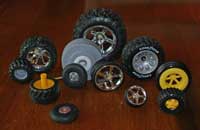
choose from
Image courtesy of Nicolas
Poynter
Choosing tyres: friction
Students are again taught about friction. Although air resistance and sliding friction are detrimental to their cars’ speed, some rolling friction is essential for the cars to move forward at all. The goal is for the students to comprehend the balance between beneficial and detrimental friction: a paved highway is better than a gravel road because there is less friction, but if ice coats the road, the cars will not be able to function without using chains to bring back some friction.
The students should choose between tyres that supply a great deal of friction and tyres that supply very little. By pure chance, each group of my students chose a different type of tyre. Unfortunately, their cars also differed in many other ways, so it was impossible to tell precisely which tyres were best. Ideally, a smaller selection of tyres might be used, and they could be tested beforehand under controlled conditions.
For us, it was obvious which tyres did not work, but not so clear which ones worked best. Smooth tyres spun a little whereas tyres with very deep treads grabbed the road too much. Wider tyres seemed to be better, but if they were too wide, their mass became an issue. The students who picked first chose abnormally large tyres with large masses. The cars with these tyres were horribly slow, so the tyres had to be exchanged. Still, the entire class learned something from watching this happen, and such mistakes can help everyone examine the science involved. The teams were allowed to change tyres at any point.
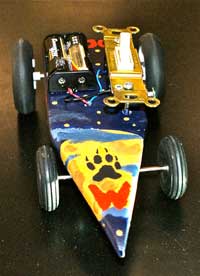
Image courtesy of Nicolas
Poynter
- Cut a 3 cm length of aluminium rod for the front axle using the wire cutters. It can be mounted using eye hooks (see image above). For a three-wheeled car, a J hook can be used.
- The gearbox axle will go in the rear.
- Allow the students to select from a variety of tyres. Depending on where they mount the gearbox (it can be mounted on top of the chassis, but seems to do better if mounted on the bottom), different cars will need different tyre diameters for ground clearance.
- Use strong glue, solder or sticky tape to secure the tyres to the axles.
Racing
- Let the teams test their functional cars to evaluate and modify them.
The most common problem was cars that ran off-course and had to have their gearboxes realigned to be square with the chassis. Slow cars often needed the screws of the gearbox to be tightened properly.
A small grub screw locks the gearbox axle into place, spinning it. It readily works itself loose and must be tightened with a hex wrench, included in the gearbox kit.
- Once all cars are in working order, start the time trials. I used two photogates as timers, 7.5 m apart and linked by a 10 m phone cord. There must be a pair of students: one flipping the switch, the other catching the car and switching the motor off.
Now the teams can see how they rate against each other. The fastest car recorded a speed of 2.776 m/s and had a mass of 298 g.
- Allow the students to make further modifications before the finals.
We had battery holders for both AA and D batteries. Two teams chose the larger batteries, incorrectly supposing that they supplied more power. During time trials, their mistake became obvious (their cars had twice the mass and half the speed of the others) and they quickly switched to the lighter AA batteries.
- Divide the class into groups of three cars per race. The lane position during the race will be very important, and there must be some way to determine who gets what lane. If your car runs straight, you want a middle lane. If your car goes a little left, you want the far right lane.
I allowed the fastest cars during time trials to select their lanes first and had textbooks lined up as retaining walls for the cars to stay on track. During the race, contact was allowed between the cars. In fact, it was common for cars to collide.
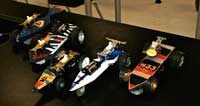
Image courtesy of Nicolas
Poynter
- Let the winners of the individual races then race each other for one overall winner.
The two fastest cars during head-to-head racing were not at the top of the list during time trials. This turned out to be the result of a hidden variable – the orientation of the switch. Most teams copied the prototype, so the switch was flipped backwards to turn the motor on, giving the car backward momentum that needed to be overcome. Two cars had the switch reversed, giving them large head starts when pitted against other cars. This did not show in the time trials because cars were timed not from a standstill but when passing the first photogate.
This turned out to be a fantastic opportunity to teach test variables (mass of the car, aerodynamics of the body shape, detrimental friction, tyres, how well the parts were assembled) and controlled variables (chassis material, gearbox, switch, 3 V battery power). The orientation of the switch came as a surprise test variable also to me: we had to analyse data to find out why the cars that won time trials did not win the races. I figured it out, but did not tell my students. To my delight, several teams came to the same conclusion independently, which was the reason for the project in the first place – to get the students thinking.
Conclusion
Through this project, my students not only achieved the academic objectives but also became better problem solvers and learned practical skills that will stay with them for the rest of their lives. Although the project needs a prototype and directions, I would suggest keeping as much variability as possible. In fact, I encouraged my students to deviate from the prototype as long as they stayed within the rules. Although some of their designs were functional disasters, the students were deeply involved in the scientific process.
References
- Hsu T (2005) Foundations of Physical Science 2nd edition. Cambridge, MA, USA: CPO Science. ISBN: 9781588921574
Web References
- w1 – You can buy a three-gear box and other supplies for building electrical and mechanical models from Tamiya. See: www.tamiya.com
Review
The article presents a novel activity for a series of physics lessons, covering a wide range of topics. In addition, teachers could use ideas in the article to stimulate a discussion of speed, velocity and acceleration or of different types of energy (e.g. kinetic and electrical).
Comprehension questions arising from the article include:
- What are gear ratios?
- How can you calculate power of a circuit?
- What is the relationship between mass, acceleration and work done?
Eric Demoncheaux, UK





